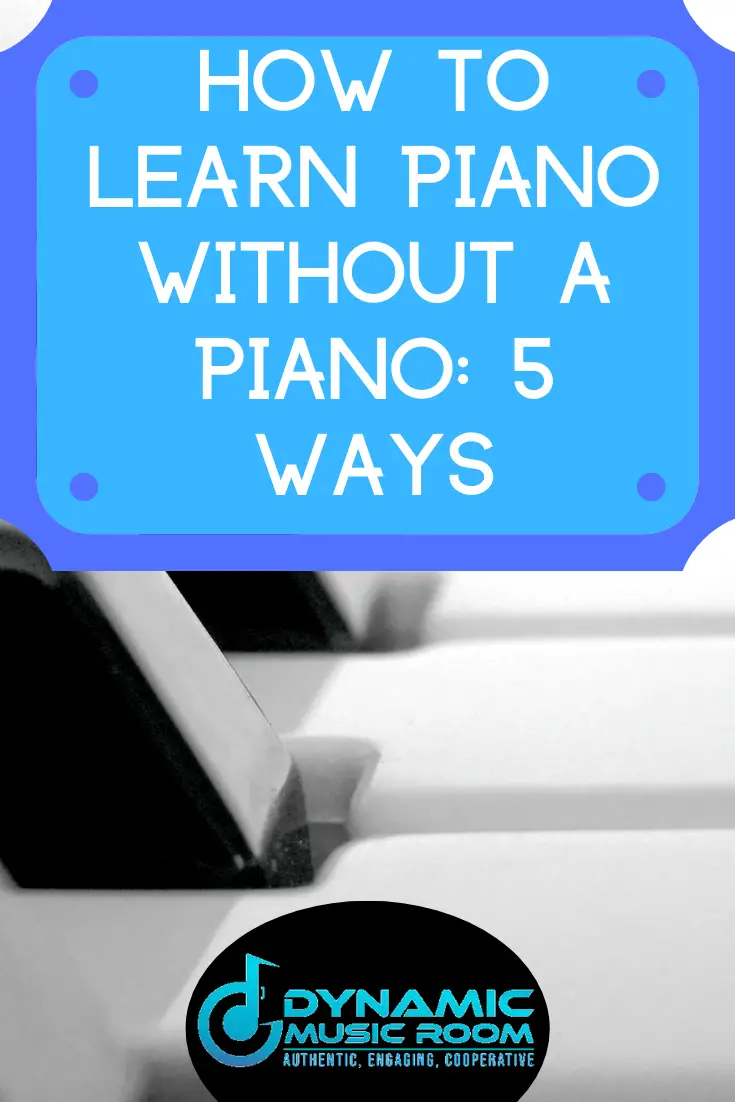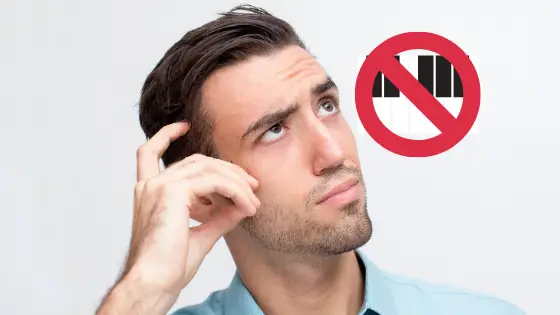Do you want to learn piano, but you don’t have one in your house currently?
Are you looking for some ways to improve and learn piano skills without actually having one in your home?
It may seem impossible, but in my music teaching experience, I’ve seen it done.
But let me be clear: you won’t be as good as you could be without a piano or keyboard to play on.
This being said, there are some tactics out there to help you with how to learn piano without a piano.
When you want to learn a piano without an actual piano, here are some options. The best choice is to get a keyboard to play on; it’s almost exactly like a piano. Other good options include using a QWERTY or computer piano, phone/tablet apps, or piano mats.
Look ahead for details and practice suggestions.
Table of Contents
5 Ways To Learn Piano Without A Piano
This section goes over the 5 main ways to learn piano without an actual piano (check out how to make a piano quieter) (check out how to make a piano quieter). I’ll go over each one and why they work or don’t work as well as piano.
Keyboard
If you’re not able to have a piano in your home, a keyboard is your best option. I strongly encourage you to consider purchasing one at some point if you’re serious about learning piano.
Keyboards in some cases will come almost in the same size as the piano. Some will have 88 keys just like a standard piano.
They’ll also often have pedals or at least inputs for pedals later on.
Some people prefer learning on a keyboard as it’s lighter, you don’t have to mess around with tuning, and the keyboard will have different sound options available.
For those with more money to spend, the Yamaha P71 is a great keyboard option for piano learners. It has all 88 keys, and the keys are weighted.
Weighted keys will give you a better feel for how real pianos feel.
This is still much cheaper than some full-sized keyboard options, but the quality of the P71 is top-notch.
For those who want to save a little, the Yamaha PSR-E263 portable keyboard has only 61 keys, but it’ll do the job for those learning piano at home.
It’s smaller by almost a third than the other option, but it still has a big enough range to satisfy 90% of piano players.
Only at the highest levels of piano playing will players really notice the difference in playing piano and keyboard.
Even then, many professional piano players will use portable keyboards to help them practice when they travel.
QWERTY Piano
A QWERTY piano is another term for a computer keyboard piano.
With this, specific letters on your keyboard are set up similar to how piano keys would be set up.
The range of the QWERTY piano is severely limited.
For most people, the QWERTY keyboard would be useful for inputting notes into a notation program, figuring out how a melody is supposed to go, and helping memorize piano keys.
The OnlinePianist provides a perfect example of such a piano.
It’s limiting in your ultimate potential, but it’ll do in a pinch.
Phone/Tablet Apps
Along similar lines, there are many apps available for phone or tablets which let you play on piano.
These are better than the QWERTY piano, but not as good as a keyboard.
Often, these piano playing apps come with some instructions and tutorials which is good as well.
Piano apps are great for helping you learn basic patterns and memorizing the piano keys.
However, because the range is limited, the key-size is inaccurate, and you’re not actually pushing anything down, the apps shouldn’t be used exclusively.
But for those who don’t have a keyboard to use, this is a good start.
Piano Mats
Piano mats are actually one of the most cost-effective ways to learn piano without a piano.
Piano mats are physical…mats…which have the keys of the piano on them.
Good ones, such as the SafePlus Piano Keyboard Mat, use all 88 keys, roll up to a small piece, and play sound when you touch the key.
These mats give you a feel for how large the keys are and provide great practice for developing finger coordination (which is the hardest part of playing the piano).
You won’t get a feel for how the keys press down and the responsiveness for touch is only OK, but you save money and get a super portable keyboard to help you focus on learning the hardest aspect of playing piano.

Finger Exercises
It’s still possible to improve on piano when you have nothing in front of you but a flat surface.
I’ve mentioned before how finger coordination is one of the most important aspects of piano playing. This is especially true in the early levels of playing.
Without any mats or keyboards, exercise your fingers to build flow and coordination. This works best if you have some sort of visual to touch your fingers to, but it isn’t needed.
While I wouldn’t suggest this as the main source of your practice, it is something available to you at any time, anywhere you are.
Here are three of my favorite finger exercises for beginners.
#1 Climbing The Mountain Together
This is one of the earliest finger exercises to do. It helps get the fingers moving together and nails down the five-finger pattern at your home position.
Both hands play the same rhythm (all quarter notes) at the same time:
- Right Hand = 1 → 2 → 3 → 4 → 5 → 4 → 3 → 2 → 1
- Left Hand = 5 → 4 → 3 → 2 → 1 → 2 → 3 → 4 → 5
#2 I’m Mad At You!
I call this one “I’m mad at you!” because it looks like the fingers start out together, move in opposite directions, and then return.
It’s basically the same idea as the first one, but now fingers move in opposite directions. Interestingly, the piano fingers are the same.
- Right and left hand = 1 → 2 → 3 → 4 → 5 → 4 → 3 → 2 → 1
#3 Take It Slow Left Hand
This is a challenging one for beginners, but it’s good to do as it builds independence in the left hand.
Both hands are playing the same they did in #1, but the right hand will now play it twice. The left hand plays the patterns once half the speed of the right hand.
For every two notes the right hand plays, the left plays one.
This exercise may be reversed to work the right hand as well.
It goes something like this:
- Right hand = 1 → 2 → 3 → 4 → 5 → 4 → 3 → 2 → 1 → 2 → 3 → 4 → 5 → 4 → 3 → 2 → 1
- Left hand = 5 →→ 4 →→ 3 →→ 2 →→ 1 →→ 2 →→ 3 →→ 4 →→ 5
Commonly Asked Questions
Can you learn to play piano without a piano? – Yes, to a certain extent.
A keyboard is your best option, but it’s still possible to better learn the piano keys and develop coordination with other methods.
However, you’ll need a piano or keyboard to continue quick growth.
How can I learn to play piano by myself? – The best way to learn piano on your own is to follow a method book AND an online course/program.
For online courses, we recommend Flowkey.
Can you learn piano on keyboard? – Yes, there is almost no loss of technique from keyboard to piano.
If possible, get a keyboard with weighted keys and piano pedals (even if they just plug in). Many people use keyboards for practice and get quite good.
Is it difficult to learn to play piano? – Yes and no. The biggest challenge on piano comes with the coordination of two hands on piano.
Fortunately, there are a ton of resources out there for improving. Unfortunately, a lot of it comes down to dedicating time and practice.
If this isn’t a problem for you, you will find learning piano largely rewarding.
How long does it take to get good at piano? – It largely depends on how good you want to get. For most people, I would say it will take at least 6 months of consistent practice to get “good.”
For more details, read our dedicated article on how long it takes to get good at piano.
Final Thoughts
I hope you enjoyed discovering how to learn piano without a piano.
If you’re using a keyboard, it’s possible to grow just as much on this as on piano; the biggest difference is learning about the piano pedals as many don’t have all the pedals (especially the middle piano pedal).
For those learning on QWERTY, apps, or mats, these will help get your fingers coordinated and learn the piano keys. At some point, you’ll need to invest in a keyboard at least.
Master 1,500+ piano songs with the fun learning program, Flowkey.
Flowkey’s learning tools and well-planned courses help piano players of any level improve.

